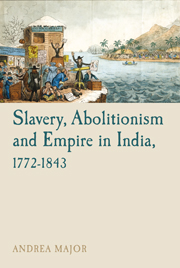Book contents
- Frontmatter
- Contents
- List of Illustrations
- Acknowledgements
- List of Abbreviations
- Glossary
- Some Prominent Figures in the British Parliament, the Abolitionist Movement and the East India Company
- Part I Other Slaveries
- Part II European Slaveries
- Part III Indian Slaveries
- Part IV Imagined Slaveries
- Introduction: Evangelical Connections
- 7 ‘Satan's Wretched Slaves’: Indian Society and the Evangelical Imagination
- 8 ‘The Produce of the East by Free Men’: Indian Sugar and Indian Slavery in British Abolitionist Debates, 1793–1833
- Conclusion: ‘Do Justice to India’: Abolitionists and Indian Slavery, 1839–1843
- Select Bibliography
- Index
Introduction: Evangelical Connections
from Part IV - Imagined Slaveries
- Frontmatter
- Contents
- List of Illustrations
- Acknowledgements
- List of Abbreviations
- Glossary
- Some Prominent Figures in the British Parliament, the Abolitionist Movement and the East India Company
- Part I Other Slaveries
- Part II European Slaveries
- Part III Indian Slaveries
- Part IV Imagined Slaveries
- Introduction: Evangelical Connections
- 7 ‘Satan's Wretched Slaves’: Indian Society and the Evangelical Imagination
- 8 ‘The Produce of the East by Free Men’: Indian Sugar and Indian Slavery in British Abolitionist Debates, 1793–1833
- Conclusion: ‘Do Justice to India’: Abolitionists and Indian Slavery, 1839–1843
- Select Bibliography
- Index
Summary
In December 1800, Baptist missionary Revd William Carey received a letter from evangelical EIC army chaplain and future vice-provost of Fort William College, Revd Claudius Buchanan, asking for his advice about the best way to put a stop to sati in India. Recording the event in his diary, Carey's colleague William Ward remarked that ‘Mr. Buchanan says that he is as anxious about this as Mr. Wilberforce is about the slave trade.’ Buchanan later provided Wilberforce with information about the number of satis in Bengal, gleaned from Carey and Ward's 1803 survey of the rite's prevalence in the area around Calcutta, while Wilberforce in turn referenced Buchanan in his speech on India in the House of Commons in 1813. Ward's brief diary entry, and the connections and correspondences that radiate out from it, provide a glimpse of the complex personal interconnections that linked evangelical EIC employees, missionaries and abolitionists in Britain and India within wider webs of colonial humanitarianism: ‘the complex cartography of philanthropic connection’, to use Lambert and Lester's phrase, through which information and ideas about the colonies were constructed and transmitted in evangelical circles in the late eighteenth and early nineteenth centuries. As Brian Pennington notes, few men at the turn of the nineteenth century had as much influence on how British Christians imagined India's Hindu population as William Ward and Claudius Buchanan, both of whom were prolific in their literary productions condemning Hindu religion and society.
- Type
- Chapter
- Information
- Slavery, Abolitionism and Empire in India, 1772–1843 , pp. 233 - 245Publisher: Liverpool University PressPrint publication year: 2012



